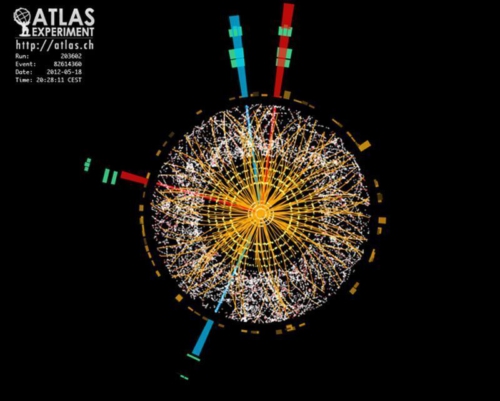CERN (European Organization for Nuclear Research) particle detection systems use Element Six synthetic diamond in their first line of defence against beam-induced radiation damage in their recently announced Higgs boson experiment results.
LONDON, July 24, 2012 /PRNewswire/ —
Element Six, the world leader in synthetic diamond supermaterials, is proud to announce that its highest purity synthetic diamond is an integral part of the CERN LHC (Large Hadron Collider) CMS (Compact Muon Solenoid) and ATLAS Beam Condition Monitoring Systems, used in the recent experiments which revealed the discovery of a new particle consistent with Higgs boson. This follows Element Six’s announcement earlier this year regarding the construction of a $30M Global Innovation Centre in the UK, to add further value and development to its performance-enabling synthetic diamond materials.

(Photo: http://photos.prnewswire.com/prnh/20120724/546269-a )

(Photo: http://photos.prnewswire.com/prnh/20120724/546269-b )
“The diamond synthesised by Element Six measures LHC beam conditions in key areas of the main experiments that have been used in the search for the Higgs boson,” said Heinz Pernegger, CERN scientist at the ATLAS experiment.
“The CMS experiment relies on the stability of the synthetic diamond sensors produced by Element Six to monitor the LHC beam arriving to the CMS experiment and the particles created in the collision. The robustness of this synthetic diamond-based system is crucial in protecting the most sensitive components of the 66 million channel pixel-tracking detector,” said Anna Dabrowski, CERN scientist at the CMS experiment.
“The use of synthetic diamond sensors was essential for a smooth operation of the LHC and the collection of high quality data by the LHC experiments, making the observation of the new particle possible,” concluded Professor Wolfgang Lohmann from the Brandenburg University of Technology.
Element Six electronic grade synthetic diamond was selected as the optimum detector material by CERN scientists over the decade-long development of CERN’s CMS and ATLAS Beam Condition Monitoring Systems. Synthetic diamond was shown to be the most robust sensor material available which could withstand the harsh, high radiation environment and react almost instantaneously to be able to protect the advanced measurement systems.
Element Six manufactures the synthetic diamond used in the detectors using a process called chemical vapour deposition (CVD). This process takes a mixture of gases and forms plasma with the extreme high temperature of a sun spot to allow carbon to precipitate onto a substrate layer as synthetic diamond.
The purpose of the CERN CMS and ATLAS experiments is to count, track and characterise the different particles produced from the particle collisions inside the LHC. The synthetic diamond detectors in the monitoring system protect the experiments from adverse beam conditions and contribute to the luminosity measurement, which was crucial for obtaining the recently published five sigma result.
The grades of synthetic diamond used in these monitoring systems are grown to ultra high levels of purity, incorporating less than one part per billion of boron, and less than 50 parts per billion of nitrogen. When diamond is synthesised with these levels of purity, it becomes an ideal radiation detector material. It can exhibit properties such as very low leakage current with negligible temperature dependence, a fast signal response and a vastly improved radiation hardness and reduction of leakage-current compared to silicon, the material traditionally used for detectors.
Adrian Wilson, Head of Technologies Division at Element Six, said:
“We are incredibly proud of the small, but important, contribution our synthetic diamond has made in helping the CMS and ATLAS experiments that are enabling the team at CERN realise their recent discoveries. We congratulate CERN and wish them continued success in their fundamental work with the Large Hadron Collider.
“This is yet another demonstration of why synthetic diamond is an ideal advanced engineering material capable of delivering extreme performance in the toughest environments. At Element Six, we are committed to cost-effectively manufacturing the highest purity synthetic diamond to help our partners meet their scientific and technology application challenges.”
Professor Dr. Erich Griesmayer, Associate Professor at the Vienna University of Technology, with more than 20 years’ experience of working at CERN, added:
“Beam condition monitoring is critical to the safe operation of the LHC at CERN. The diamond synthesised by Element Six is able to provide that protection in key areas of the main experiments that have been used in the search for the Higgs boson. Now that the synthetic diamond has been proven in this application, there is scope for its further use in medicine such as radiation therapy and diagnostic imaging.”
Notes to Editors:
About Element Six
Element Six (http://www.e6.com) is an independently managed synthetic diamond supermaterials company. Element Six is part of the De Beers Family of Companies. Element Six is a global leader in the design, development and production of synthetic diamond supermaterials, and operates worldwide with its head office registered in Luxembourg, and primary manufacturing facilities in China, Germany, Ireland, Sweden, South Africa and the UK.
Element Six supermaterial solutions are used in applications such as cutting, grinding, drilling, shearing and polishing, while the extreme properties of synthetic diamond beyond hardness are already opening up new applications in a wide array of industries such as optics, power transmission, water treatment, semi-conductors and sensors.
Further information
For high resolution images, please contact Iain Hutchison in the Element Six press office. For further information, please contact:
Iain Hutchison, Element Six Group Communications and Brand Manager
Email: iain.hutchison@e6.com
Telephone: +44-(0)20-8742-4949
CERN Press Office
Email: press.office@cern.ch
Telephone: +41-22-76-734-32
SOURCE Element Six Ltd
